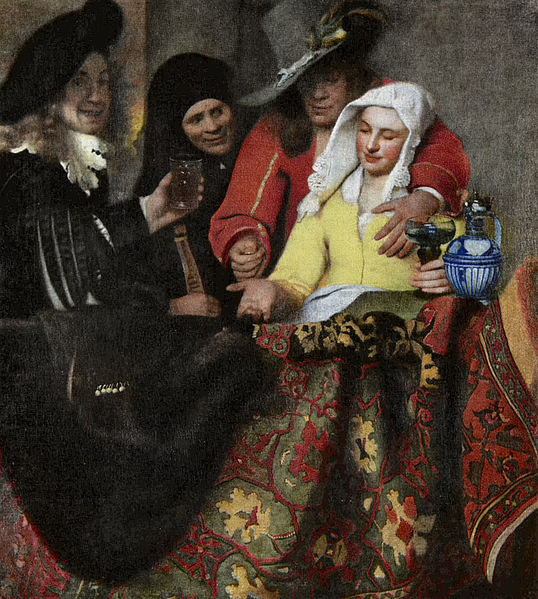The painting, The Procuress (1656), has long been suspected to be atypical of Johannes
Vermeer’s painterly style and characteristics: the airiness the painter often favoured
gives way to a more limited space and its light treatment, except a more
prominent one on the carpet, is confusedly rudimentary, as if the whole canvas was
emerging from a film of smoke and sands. Depicted here a brothel scene, but any
feelings of seediness or raucousness are diluted, presumably for the sake of
decency, which is an undercurrent flows beneath Vermeer’s oeuvre, attests to
the Dutch master’s contemporary role as an unsung genius.
What is peculiar about this painting is the
man on the left, long rumoured to be the self-portrait of the painter, who is
seen staring casually into the viewers. The glance is a conspiratorial one,
seemingly in complicity with the beholders. This imposed intimacy generates an
unnerving effect; unconsciously the viewers do find themselves return the
uncanny glance, in hope of plumbing any illicit secrets. Conspiratorial glances
are not too rarely found in paintings. In Edouard Manet’s ubiquitous Luncheon on the Grass (1862-3), the nude
model turns her gaze boldly to the front, assuming admirable confidence and
ease when mingling with two well-attired gentlemen. What abhorred the viewers
of the 19th century was not the subject of nudity, but the
juxtaposition of formality and facetiousness, and moreover, the unflappable
gaze that speaks of her liberation from the fetters of social protocols, and
her assertion as a woman with independence: she who makes her own choices; she
who is unafraid of parading her womanly attributes.
The conspiratorial glances sometimes
question us, of the things that we are squeamish to face, and the answers we
dread to give. A murkier instance can be seen in Hieronymus Bosch’s Haywain Triptych (1500-2). On its right
panel, where all human sins run amok, stands a bull in the midst of the hellish
commotion. Despite the hectoring of the infernal beings the bull halts before
the gate to Hell, hesitant to be led to its final damnation and instead,
prefers to let its emotion flow. It is especially an agony when amid a crowd of
senseless violence and vices an innocent and sentient being still subsists. The
pitiable creature turns its gaze at us, its meekness still fills its eyes,
seemingly to implore our sympathy and mercy. This is the moment when all words
muted on our mouths.
Eyes can disclose unwittingly the secrets
that are best to be hidden, but they can also be observant, furtively and
steadily discovering the secrets of others. Therefore my eyes instinctively
dwell on the second man from left in our painting. Something about the couple
on his right obviously interests the man. A smile of wiles and malice plays
upon his mouth, and our eyes, despite how keenly and closely we scrutinize the
painting we fail to tease out the possible hidden agenda of the smiling man and
what is actually happening in this painting.



Comments
Post a Comment